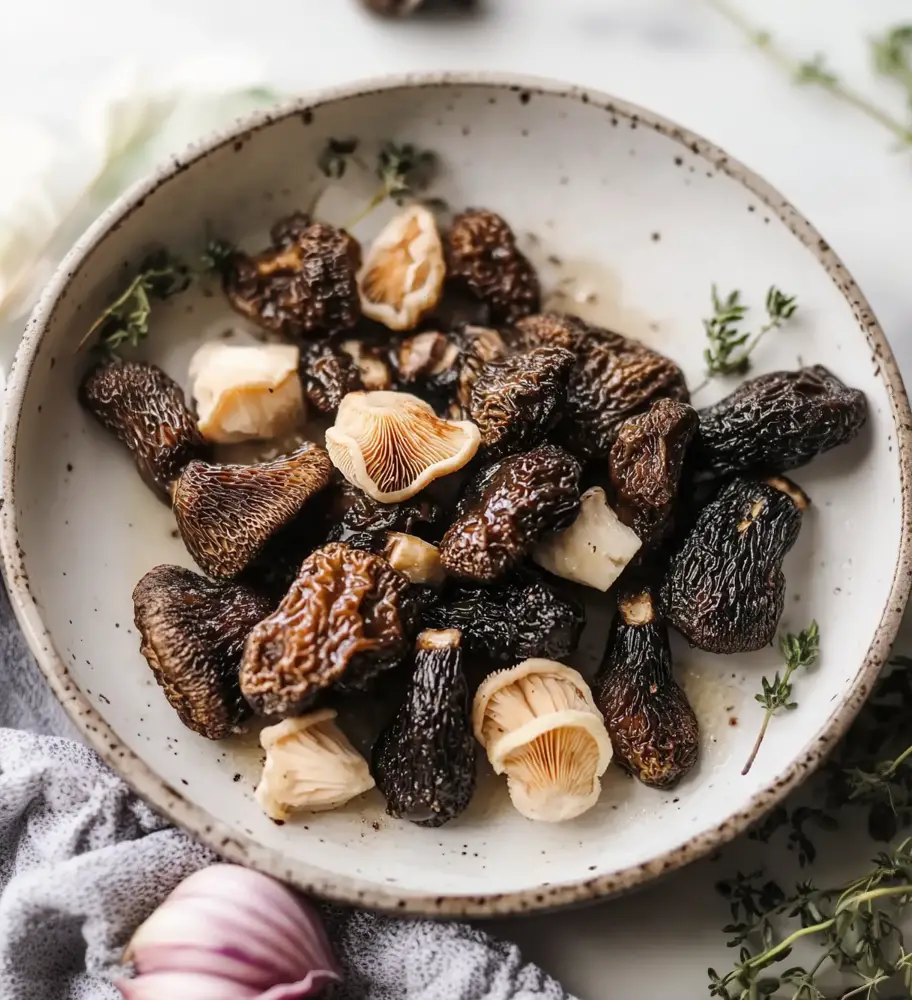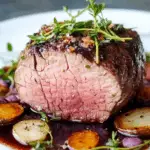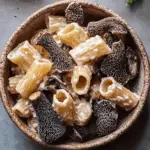This sautéed morel mushrooms recipe celebrates the unique, earthy flavor of morels, a prized wild mushroom known for its honeycomb texture and rich taste. Perfect as a simple side dish or an elegant appetizer, this recipe highlights the mushrooms’ natural flavor with minimal ingredients and quick cooking. It’s a great way to enjoy seasonal mushrooms that add a gourmet touch to any meal.
Full Recipe:
Ingredients
- 8 ounces fresh morel mushrooms, cleaned and sliced
- 2 tablespoons unsalted butter
- 1 tablespoon olive oil
- 1 small shallot, finely minced
- Salt, to taste
- Freshly ground black pepper, to taste
- 1 tablespoon fresh parsley, chopped (optional)
- Lemon juice, a few drops (optional)
Directions
- Clean the morel mushrooms gently by brushing off dirt or rinsing quickly and drying thoroughly. Slice them into halves or quarters depending on size.
- Heat the butter and olive oil in a skillet over medium heat until the butter melts and starts to foam.
- Add the minced shallot and sauté until translucent and fragrant, about 1-2 minutes.
- Add the morels to the skillet in a single layer. Cook without stirring for about 3-4 minutes to allow the mushrooms to brown.
- Stir the mushrooms gently and continue cooking for another 3-4 minutes until tender and cooked through.
- Season with salt and freshly ground black pepper to taste.
- Remove from heat, optionally sprinkle with chopped parsley and a few drops of lemon juice for brightness.
- Serve immediately as a warm side dish or appetizer.
Nutrients (approximate per serving)
- Calories: 110 kcal
- Protein: 3 g
- Fat: 10 g (mostly from butter and olive oil)
- Carbohydrates: 4 g
- Fiber: 2 g
- Sodium: 150 mg (depends on salt added)
- Vitamin D: Moderate (morels are a good source)
- Iron: Moderate
What Makes Morel Mushrooms Special?
Morels belong to the genus Morchella, which comprises several species found mainly in temperate regions. These fungi grow wild in forests, often near dead or dying trees, thriving in moist environments after the winter thaw. Their rarity and difficulty to cultivate commercially add to their mystique and price.
Morels have a spongy texture that soaks up flavors beautifully when cooked. This, combined with their subtle smokiness and mild earthiness, makes them a favorite among mushroom enthusiasts. Nutritionally, morels are low in calories but rich in vitamins and minerals, including vitamin D, iron, copper, and manganese, making them a healthy addition to any meal.
The Culinary Appeal of Morels
Morels are versatile and can be prepared in various ways—grilled, stuffed, fried, or added to soups and sauces. However, the simplest preparation methods often bring out the best in them. Sautéing morels in butter and olive oil with a bit of shallot is a classic technique that enhances their natural flavor and adds a satisfying richness without overshadowing the mushrooms themselves.
This dish works perfectly as a side or an appetizer, complementing a wide range of main courses, from grilled meats to pasta dishes. The slight caramelization that occurs during sautéing adds a lovely depth of flavor and a pleasant texture contrast.
Harvesting and Preparing Morels
Before cooking, it’s crucial to clean morels properly because their honeycomb structure tends to trap dirt, insects, and debris. Gently brushing them with a soft brush or rinsing quickly under cold water and drying thoroughly are common methods. Soaking morels is generally discouraged as they can become waterlogged, losing flavor and texture.
When selecting morels, freshness is key. Look for firm mushrooms with a rich brown color and no slimy spots or mold. Fresh morels have a distinct earthy aroma, which fades if they are old or improperly stored. If you find dried morels, rehydrating them in warm water before cooking can bring back much of their flavor, though the texture will differ slightly from fresh mushrooms.
Pairing Sautéed Morels
The delicate flavor of sautéed morels pairs beautifully with complementary ingredients. Fresh herbs like parsley or thyme add brightness, while a squeeze of lemon juice can lift the earthiness with a touch of acidity. They also marry well with rich ingredients such as cream, butter, or mild cheeses, which balance their woodsy taste.
Morels enhance dishes like risottos, egg-based meals like omelets or frittatas, and even savory pastries. They also work well alongside proteins such as chicken, veal, or pork, adding an elegant touch without overwhelming the palate.
Health Benefits of Morel Mushrooms
Morel mushrooms are not just flavorful; they also bring nutritional benefits. They are an excellent source of antioxidants, which help combat oxidative stress and inflammation in the body. Their vitamin D content is significant, especially when mushrooms are exposed to sunlight or UV light during growth, which supports bone health and immune function.
Morels also contain iron and copper, essential minerals for energy production and the formation of red blood cells. Their dietary fiber aids digestion and promotes gut health. Because morels are low in calories and fat, they are a great choice for those seeking nutrient-dense but light foods.
Seasonality and Sourcing
Morels have a brief growing season, typically emerging in the spring, which can vary by region but usually lasts a few weeks. This limited availability often leads to higher prices and makes morels a special treat rather than an everyday ingredient.
For those interested in foraging, knowledge of safe mushroom identification is crucial, as there are poisonous look-alikes. Many people prefer to buy from trusted specialty markets or farmers who harvest them sustainably.
Dried morels are available year-round and can be a good alternative to fresh ones, though rehydration is needed, and some flavor nuances may be lost.
Sautéed Morels in Gastronomy
In fine dining, sautéed morels are often used as a luxurious garnish or a highlight of spring menus. Their complexity and rarity make them a symbol of culinary sophistication. Chefs appreciate how their flavor intensifies with simple cooking techniques, allowing them to shine without complicated preparations. This dish also fits well into farm-to-table and seasonal cooking philosophies, celebrating the natural bounty and rhythms of the environment. Sautéed morels encourage diners to savor the fleeting flavors of spring.
Tips for Perfect Sautéed Morels
To get the best results, use a heavy-bottomed skillet or cast-iron pan to ensure even heat distribution. Cooking morels over medium heat allows them to brown nicely without drying out. Avoid overcrowding the pan, which causes mushrooms to steam rather than sauté, losing their desirable texture. Timing is essential; overcooking can make morels rubbery and tough, while undercooking leaves them gritty or chewy. Adding salt too early can also draw out moisture prematurely, so it’s best to season toward the end of cooking.
Conclusion
Sautéed morel mushrooms offer a sublime culinary experience that balances earthiness, texture, and rich flavor. Their rarity and seasonal nature make them a special ingredient that elevates simple dishes into memorable meals. Whether served as an elegant appetizer or a luxurious side, this recipe highlights the delicate qualities that make morels beloved in kitchens around the world.






